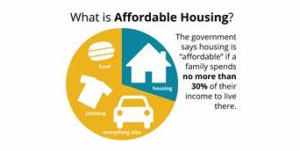Looking into Affordable Housing Issues and Their Remedies
Making Unaffordable to Affordable: Looking into Affordable Housing Issues and Their Remedies
Affordable Housing is a critical issue in many developing countries that impacts their potential for sustainability and socio-economic development.
Lack of affordable housing, slower growth of housing stock, and aging housing conflates numerous other problems in Pakistan, including overcrowding, poor indoor air quality, prevalence of preventable diseases, and development of slums and kat chi abides, etc.

These challenges lessen living standards in many areas. Unaffordable housing forces low-income families in urban areas to live in dilapidated areas. An increase in the construction of affordable housing is needed to mitigate housing affordability challenges in Pakistan.
Setting aside land quotas for low-income families in housing development schemes is not sufficient because the households still lack the means to construct housing. This paper attempts to identify the causes of unaffordable housing and solutions for its provision.
Affordable housing is a crucial issue these days in developing countries owing to swift population expansion. Population in developing and under-developed countries mostly live either around or below the poverty line.
It is a substantial challenge for poor people to build or purchase a home in urban areas where the prices of lots and development costs are outrageous. Poverty and homelessness are prime factors that force poor people to live in slums, katchi abadies, and squatter settlements.
Housing unaffordability is considered as a threat to prospective sustainable development of developing countries while also upsurge the prevailing housing shortfall of cities. Housing affordability has declined due to supply constrains in formation of new housing supply and also due to inflation in building material`s prices.
To address these challenges, local municipalities need to dig out the facts and work accordingly to mitigate the housing shortage and enable such environment that strengthen the departments and legal framework to provide affordable housing to penurious segment of society.
The research work is conducted in an explorative mode to identify the causes of unaffordable housing and correspondingly to suggest the remedial measures. Formerly, there was a need to dissect the housing dimensions in Lahore while also to evaluate the correspondence of housing disbursement and affordability.
Whereas, the foremost research question is to reach a consensus-based decision on the worst cause and its utmost remedies to attain the ambitious affordable and decent housing
The term “affordable” has no absolute meanings as it is a relative concept and could have numerous meanings in different perspectives but the “affordability refers to people’s ability to purchase basic (or essential) goods and services such as healthcare, food and shelter”.
The definition of “affordable housing” has been merging over time, but there are a few similarities in relevant literature. Affordable housing can also have connotations as it “refers to any housing that meets some form of affordability criterion, which could be income level of the family, size of the dwelling unit or affordability in terms of EMI size or ratio of house price to annual income”. While Daniel Shaw (2016) defines the housing affordability as the provision of “housing units to the eligible households whose needs are not met by the market”.
In literature, the researchers have also explained the relation of housing affordability with expenditure as “housing costs (including rents, mortgages, property taxes and insurance, maintenance and basic utilities) that costs less than 30 % of household income or budgets, but some experts recommend including other costs”.
But in the case of Lahore, about 64 % of the people can save nothing from their household income as they spend the whole of their income on house[1]hold expenditure. Most people are living on a rental basis, while a few have not paid the rent for several months.
This hand-to-mouth situation will bring them on the road one day if the target of housing for poor people is not achieved. The other side of the coin depicts the situation as unaffordability or even worse for people in extreme poverty.
